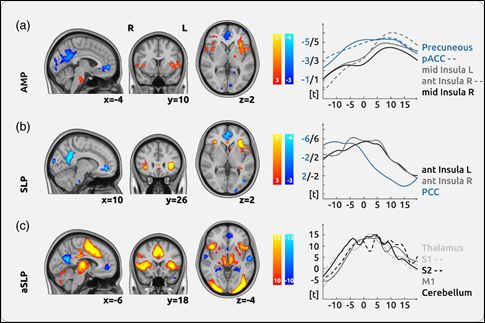Exploring cortical coding of endogenous chronic pain and effective pain relief strategies
Investigators: Viktor WITKOVSKÝ, Gejza WIMMER, Jr., Laura HAJZOKOVÁ Institute of SAS Measurement, v.v.i. + foreign partners
In collaboration with our partners, we investigated the problem of understanding endogenous chronic pain with the aim of finding and elucidating mechanisms to alleviate suffering. Therefore, we focused on studying the course of brain activity in patients with migraine during the migraine cycle and in patients with chronic back pain. The pathophysiology of migraine as a complex neurological disorder is not yet fully understood, but the clinical signs of the disease, such as cyclic seizure behaviour and vegetative symptoms, suggest a significant role of the hypothalamus. In a longitudinal study, functional magnetic resonance imaging (fMRI) was used to investigate the rhythmicity of cerebral perfusion and hypothalamic connectivity during the migraine cycle. Our results confirm the role of the hypothalamus in the development of migraine attacks. With our approach, we aimed to elucidate how intrinsic functional networks evolve in response to the fluctuating intensity of chronic pain. The observed diversity of individual cortical outcomes of chronic pain encoding supports the understanding of chronic pain as a complex and multilayered condition. An important aspect of our research is the observed variability. We found that there is an individual level of brain modulation in each subject. Our proposed assessment of persistent endogenous pain is a promising tool to assess the patient’s pain coding and subsequently develop a cognitive strategy for pain relief. The main task of IMS SAS was software development and statistical data analysis using linear mixed effects models.
Fig. 1. Illustration of cortical processing in chronic back pain (CBP). (a) Cortical encoding of endogenous pain intensity. (b) Processing changes in pain intensity. (c) A movement process that requires motor activity and decision making. The graphs on the right show the time dynamics of the hemodynamic delay for several regions in relation to the current pain rating.
Project partners:
- Department of Neurology, LMU University Hospital, Ludwig-Maximilians-Universität, Munich, Germany
- Department of Medical Psychology, Ludwig-Maximilians-Universität, Munich, Germany
- Department of Clinical Neurosciences, University of Oxford, UK
Related publications 2021 / 2022:
- JAHN, P. – DEAK, B. – MAYR, A. – STANKEWITZ, A. – KEESER, D. – GRIFFANTI, L. – WITKOVSKÝ, Viktor – IRVING, S. – SCHULZ, E. Intrinsic network activity reflects the ongoing experience of chronic pain. In Scientific Reports, 2021, vol. 11, no. 1, art. no. 21870. ISSN 2045-2322. (4.379 – IF2020) Q1, D1. Available at: https://doi.org/10.1038/s41598-021-01340-0
- STANKEWITZ, A. – KEIDEL, L. – REHM, M. – IRVING, S. – KACZMARZ, S. – PREIBISCH, C. – WITKOVSKÝ, Viktor – ZIMMER, C. – SCHULZ, E. – TOELLE, T.R. Migraine attacks as a result of hypothalamic loss of control. In NeuroImage: Clinical, 2021, vol. 32, art. no. 102784. ISSN 2213-1582. (4.881 – IF2020) Q1, D1. Available at: https://doi.org/10.1016/j.nicl.2021.102784
- DEAK, B. – EGGERT, T. – MAYR, A. – STANKEWITZ, A. – FILIPPOPULOS, F. – JAHN, P. – WITKOVSKÝ, Viktor – STRAUBE, A. – SCHULZ, E. Intrinsic network activity reflects the fluctuating experience of tonic pain. In Cerebral Cortex, 2022, vol. 32, no. 18, p. 4098–4109. ISSN 1047-3211. (4.861 – IF2021) Q1. Available at: https://doi.org/10.1093/cercor/bhab468
- MAYR, A. – JAHN, P. – STANKEWITZ, A. – DEAK, B. – WINKLER, A. – WITKOVSKÝ, Viktor – EREN, O. – STRAUBE, A. – SCHULZ, E. Patients with chronic pain exhibit individually unique cortical signatures of pain encoding. In Human Brain Mapping, 2022, vol. 43, no. 5, p. 1676-1693. ISSN 1065-9471. (5.399 – IF2021) Q1. Available at: https://doi.org/10.1002/hbm.25750
- MAYR, A. – JAHN, P. – DEAK, B. – STANKEWITZ, A. – DEVULAPALLY, V. – WITKOVSKÝ, Viktor – DIETRICH, O. – SCHULZ, E. Individually unique dynamics of cortical connectivity reflect the ongoing intensity of chronic pain. In Pain, 2022, vol. 163, no. 10, p. 1987-1998. ISSN 0304-3959. (7.926 – IF2021) Q1. Available at: https://doi.org/10.1097/j.pain.0000000000002594. Editor’s Choice – Video: https://cdn-links.lww.com/permalink/pain/b/pain_2022_01_24_schulz_pain-d-21-00996_sdc2.mp4
 Contacts
Contacts Intranet
Intranet SK
SK
